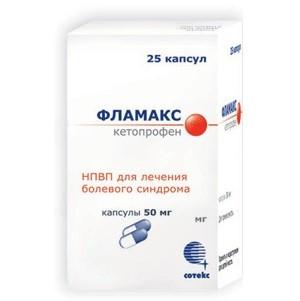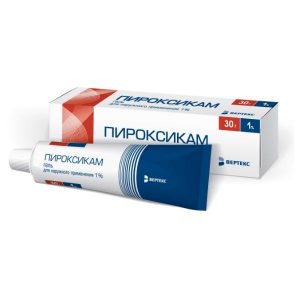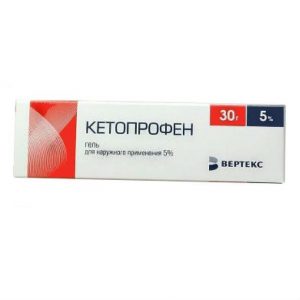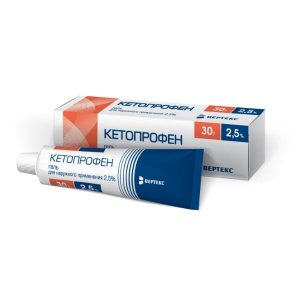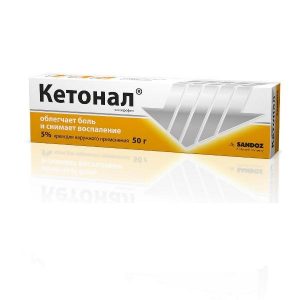Description
Release form
Capsules
Pharmacological action
Pharmacodynamics
Nonsteroidal anti-inflammatory drug (NSAID), a derivative of propionic acid. It has anti-inflammatory, analgesic and antipyretic, anti-aggregation effects. Suppresses the activity of cyclooxygenases 1 and 2, regulating the synthesis of prostaglandins. The analgesic effect is due to both central and peripheral mechanisms. It has anti-bradykinin activity, stabilizes lysosomal membranes.
Pharmacokinetics
Absorption – fast, bioavailability – 90%. Up to 99% of the absorbed ketoprofen binds to plasma proteins, mainly with albumin. The maximum concentration of the drug in plasma (Cmax) is achieved quickly (0.5-2 hours after ingestion) due to the low volume of distribution (0.1-0.2 l / kg). The equilibrium concentration (Css) of ketoprofen in plasma is achieved 24 hours after the start of its regular intake. Ketoprofen penetrates well into the synovial fluid and connective tissue. The maximum concentration in the synovial fluid is 30% of the concentration in the serum, and 4-6 hours after administration exceeds it. Ketoprofen crosses the blood-brain barrier. Almost completely metabolized in the liver by glucuronidation, it has the effect of “first passage” through the liver. It is excreted by the kidneys (mainly) and intestines (1-8%). The half-life of ketoprofen (T1 / 2) is 1.6-1.9 hours. In the elderly, the half-life is increased to 3-5 hours, in patients with renal failure (creatinine clearance of 20-60 ml / min) is about 3.5 hours Does not cumulate.
Contraindications
– hypersensitivity to ketoprofen or to any component of the
drug – a history of bronchial asthma caused by ketoprofen, another non-steroidal anti-inflammatory drug or acetalysalicylic acid
– recurrent peptic ulcer of the stomach and duodenum
– peptic ulcer
– severe hepatic insufficiency
– severe renal failure
– blood circulation and blood circulation )
– pregnancy and lactation
– children’s age (up to 15 years)
– hemophilia and other blood clotting disorders s rdlkp – ulcerative colitis, Crohn’s disease, diverticulitis.
Precautions
Anemia, bronchial asthma, alcoholism, smoking, alcoholic liver cirrhosis, hyperbilirubinemia, hepatic and renal (since the drug is mainly excreted by the kidneys) failure, diabetes mellitus, dehydration, sepsis, chronic heart failure, edema, arterial hypertension, coronary heart disease, blood diseases (including leukopenia), stomatitis, childhood (over 15 years), old age.
Pregnancy and lactation
The use of ketoprofen is contraindicated in pregnancy and lactation.
Special instructions
With the simultaneous use of ketoprofen and warfarin, as well as coumarin anticoagulants or lithium salts, patients should be under strict medical supervision.
Caution must be exercised when prescribing the drug to patients with a history of gastrointestinal ulcer, renal or hepatic insufficiency. During treatment, it is necessary to control the picture of peripheral blood and the functional state of the liver and kidneys. In case of impaired renal and hepatic function (increased ALT activity is the most sensitive indicator of NSAID-induced liver dysfunction), dose reduction and careful monitoring are necessary.
If it is necessary to determine 17-ketosteroids, the drug should be discontinued 48 hours before the study.
Like other drugs in this group, it can mask signs of an infectious disease.
When developing disorders of the organs of vision, an ophthalmologist should be consulted.
During the treatment period, care must be taken when driving vehicles and engaging in other potentially dangerous activities that require an increased concentration of attention and speed of psychomotor reactions.
Composition
active substance: 50 mg ketoprofen,
excipients: lactose monohydrate, microcrystalline cellulose, croscarmellose sodium, sodium lauryl sulfate, povidone, colloidal silicon dioxide.
Composition of the gelatin capsule: titanium dioxide, gelatin, indigo carmine FD&C blue.
Dosage and Administration
Inside, with meals. For rheumatic diseases, 1 capsule in the morning, 1 afternoon and 2 in the evening or 4 times a day, 1 capsule. Perhaps the combined use of dosage forms.
In patients with renal failure, the dose is reduced to 33-50%, in elderly patients the dose is adapted to age.
In the treatment of pain and algodismenorea, the dose, if necessary, is 25-50 mg of ketoprofen every 6-8 hours.
The maximum daily dose is 300 mg.
Side effects
– From the digestive system: NSAIDs, gastropathy, abdominal pain, dyspepsia (nausea, vomiting, heartburn, flatulence, decreased appetite, diarrhea), stomatitis, taste change, ulceration and perforation of the gastrointestinal mucosa gingival, gastrointestinal, hemorrhoidal bleeding, increased activity of liver transaminases in the blood serum, hepatitis.
– From the nervous system: headache, dizziness, insomnia, agitation, nervousness, drowsiness, depression, asthenia, confusion or loss of consciousness, forgetfulness, migraine, peripheral neuropathy.
– From the sensory organs: tinnitus or ringing, blurred vision, conjunctivitis, dry eyes, eye pain, conjunctival hyperemia, hearing loss, vertigo.
– From the cardiovascular system: increased blood pressure, tachycardia.
– From the hemopoietic organs: rarely – agranulocytosis, anemia, hemolytic anemia, thrombocytopenia, leukopenia.
– From the urinary system: edematous syndrome, cystitis, urethritis, impaired renal function, interstitial nephritis, nephrotic syndrome, hematuria.
– On the part of the respiratory system: hemoptysis, dyspnea, bronchospasm, rhinitis, laryngeal edema, nosebleeds, shortness of breath.
– On the part of the skin: skin rash, alopecia and eczema, exudative erythema, incl. Stevens-Johnson syndrome, toxic epidermal necrolysis (Lyell’s syndrome), photodermatitis.
– Allergic reactions: skin rash (including erythematous, urticaria), pruritus, rhinitis, angioedema, exfoliative dermatitis, anaphylactic shock.
– Other: increased sweating, myalgia, muscle twitching, shortness of breath, thirst, vaginal bleeding.
Overdose
Symptoms: drowsiness, nausea, vomiting, abdominal pain, bleeding, and liver and kidney dysfunctions are possible.
Symptomatic treatment: gastric lavage and / or activated charcoal and / or other sorbents. There is no specific antidote.
Drug interaction
Reduces the effectiveness of uricosuric drugs, enhances the effect of anticoagulants, antiplatelet agents, fibrinolytics, ethanol, side effects of glucocorticosteroids and mineralocorticosteroids, estrogen reduces the effectiveness of antihypertensive drugs and diuretics.
Joint administration with other NSAIDs, glucocorticosteroids, ethanol, corticotropin can lead to ulceration and the development of gastrointestinal bleeding, to an increased risk of developing renal dysfunction.
Concomitant use with oral anticoagulants, heparin, thrombolytics, antiplatelet agents, cefoperazone, cefamandol and cefotetan increases the risk of bleeding.
Increases the hypoglycemic effect of insulin and oral hypoglycemic drugs (dose recalculation required).
Inductors of microsomal oxidation in the liver (phenytoin, ethanol, barbiturates, rifampicin, phenylbutazone, tricyclic antidepressants) increase the production of hydroxylated active metabolites.
Co-administration with sodium valproate causes impaired platelet aggregation.
Increases the plasma concentration of verapamil and nifedipine, lithium preparations, methotrexate.
Antacids and colestyramine decrease absorption.
Myelotoxic drugs enhance the hematotoxicity of the drug.
Storage conditions
Store in a dry, dark place at a temperature not exceeding 25 ° C.
Keep out of the reach of children.
The Expiration of
is 3 years.
Deystvuyuschee substances
Ketoprofen
pharmacy outlets p14f35 pharmacy s14lfp
Prescription
Form of Treatment
kapsul
